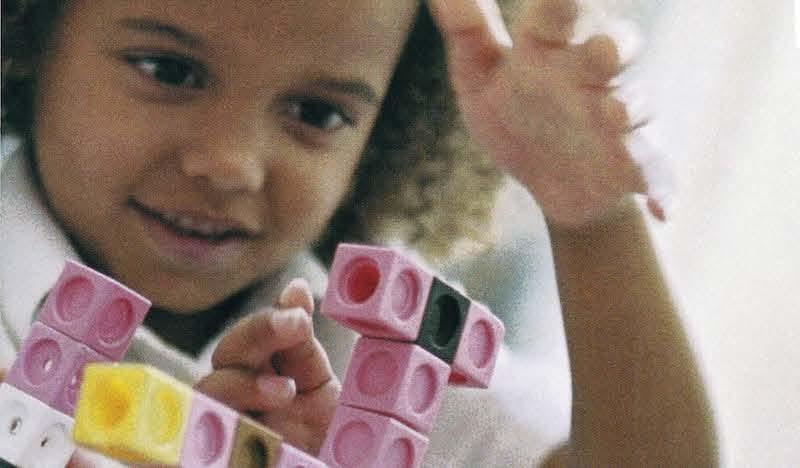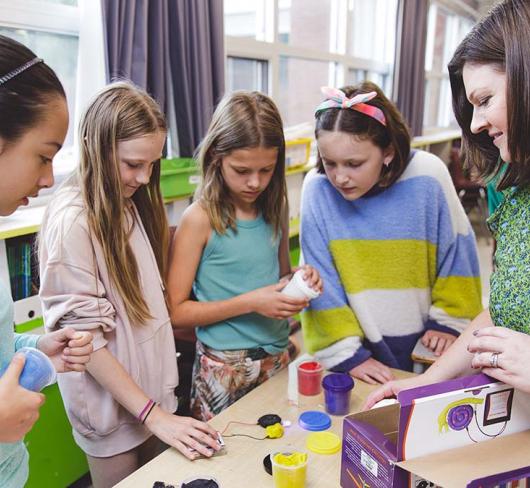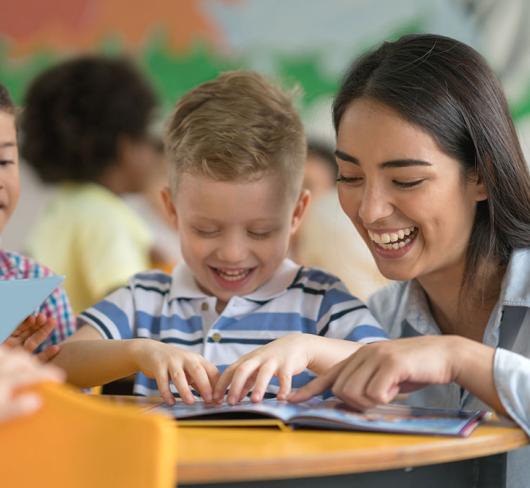
Begin with Science and Technology and Integrate
Teaching science and technology is an outstanding way to provide experiences that are valid, testable and repeatable.
Primary teachers know that experiences are linchpins for extending concepts. This is also true in junior and intermediate classrooms, and it extends to secondary, skilled trades, the workplace in all its variations, and post-secondary education.
Teachers are, for the most part, the result of a primarily abstract postsecondary and professional degree program. We abstract well. Most of our students, however, will participate in a primarily concrete world. Only about 30 percent of them will go on to abstract post-secondary studies. Yet the research shows that all students benefit from hands-on experiences in which they can participate equally. These experiences help them relate to abstract concepts and provide an experiential foundation on which to build further learning.
Not long ago, I was observing my students working at their final projects, solving problems, questioning, reflecting, designing, socializing. Just doing learning, making meaning of their learning, and applying their learning. I was unneeded. I had done my job. Now the students were showing their stuff. Granted it was only a moment, probably no more than five seconds, before I was brought back to earth. Two students wanted to use the reciprocating sander at the same time as the vice-principal wanted to know what I had seen of intruders in the schoolyard. Nevertheless, this wondrous moment was based on experiences from a wide application of literacy, numeracy and intellectual social interaction.
For me, starting with science and technology and integrating feels right. It often works to get all kinds of students learning and understanding, not merely memorizing and doing well on some kind of paper and pencil test, the answers to which are forgotten as soon as the test is over.
A year after I arrived in Canada, my grade 6 teacher taught us the science of water. He did this by teaching us how to cook carrots, onions and hot dogs on an open fire in our schoolyard. This exercise showed that vegetables and meat contain water and that, when heated, water evaporates, expands, and sometimes escapes from hand-made foil pouches. What an incredibly digestible science and technology experience.
Of course, we had to write about and do mathematics about our experiences, including observations, before, during and after the heating. The best part was that we used all our senses, including taste and smell, to describe the effects of heat on vegetables and meat. We had to draw diagrams, both scientific (literal) and artistic (figurative or abstract).
These two experiences show how the linkages between foundation experiences, from a science and technology beginning, can lead to integration across the curriculum. These linkages are clearly effective in both short-term student involvement, as well as in long-term memory and in linking experiences to concepts. We all have these kinds of memories, which indelibly stamp the ways in which we understand the world.
How does integrating science and technology fit with your classroom practices?
You may be asking
- Why bother? If EQAO is a paper-andpencil test, we should be teaching paper-and-pencil work only.
- Will it mean more work for me setting up good experiences that are curriculum-driven ?
- Is there any good research to back this up?
Why Bother?
The answer is clear. You must. The curriculum requires it in most areas and students’ developmental stages require it too. Having good experiences helps students write and reflect from their own perspectives, as well as providing a foundation from which to extend and modify further learning.
More Work?
While the answer is no, you will have to be creative and hand a little more power to your students. Give students interesting experiences, in or out of the classroom, messy or clean, and take some tangents. Giving students opportunities and permission to express themselves in their personal learning styles will probably translate into less work for you in setting up paper-and-pencil tasks that have to be photocopied and marked. Another benefit is that reducing the amount of photocopying means more funds may be available for science and technology materials!
Research Results
There is bountiful research that supports integration across the curriculum. Maria Montessori and Dale Edgar (experientialists); Ernst von Glasersfeld (radical constructivism); and Howard Gardner (multiple intelligences) have all written in support of this concept. As well, new research with regard to brain-based learning shows that linking learning and meaning-making to rich cross-curricular experiences gets results.
There are some down sides. Some students need structure, lots of it, to be successful. You can still provide structure, just not all the time. Allow for conceptualization, making connections, and reflecting. Be flexible in what you consider 'assessable performance'. You may need to explain to some parents that standardized testing may work for largescale assessments, but your students' individual learning must be honoured. The Ontario curriculum, and especially science and technology, is full of verbs and implications for experiences. These verbs include: investigate, describe, model, infer, reflect, relate, design, and build. Actions that the curriculum requires are best delivered from a foundation of learning experiences.
Here is one example of a ‘begin with science and technology experience’ that led to integrated learning and high student performance on multiple levels.
Example 1
Earth Day Learning
I was wondering what my students and I could do for Earth Day. We had just finished studying living things, but it was still too cold for an ecosystem hike to see living things. However, it was messy enough around our schoolyard and immediate neighbourhood to do a good clean-up.
We discussed the safety rules for picking up waste, especially sharp objects and biological waste (health and safety systems; science and technology; and health and physical education). We collected and logged the raw materials from the schoolyard and neighbourhood (math and social studies) first on a map and then on a tally sheet.
Students sorted the raw materials and discarded those that were unsuitable for our intended purpose: the creation of litter critters (creative art expectations). Students then designed creatures that had specific features and built their critters (science and technology).
The next step was to create a story. From the perspective of their litter critter, as an intelligent alien, students reported either on what could be done to ensure our earth is treated properly, or wrote a story describing how their critter came into being and what special features it possessed (literacy and science and technology). Finally, students composed a presentation portfolio (arts) which was shared with other classes describing the process (science and technology and literacy), the final outcome of their Earth Day litter critter and how they had helped the earth through this experience.
Example 2
Frames
A second example is drawn from a visit to two Halton DSB grade one teachers last year and subsequently backed up by teachers at the Science Teachers’Association of Ontario (STAO) 2002 conference.
These teachers began a unit on “Frames.” Students were taught how to make frames using Pop-side sticks, wood, glue, and gussets. The frame is a science and technology expectation in the structures strand for several grades of the curriculum. It is a wonderful way to have students test the strength (pure science and technology) of various bonding agents (glue versus flour paste versus glue stick).
Students test the frame’s strength by using non-standard measuring devices, such as amount of scoops of sand, to see how much it can stand before breaking, (science and technology, mathematics).
To make the frame, students
- Cut triangular gussets (math, art, science and technology).
- Glue and line up the gussets with the sticks using the sandwich method (science and technology, math, art).
- Press on the gusset-glue-stick - sandwich and count to 20 (math).
- Complete the frame by repeating this procedure for all four corners.
The completed frame presents a number of artistic, scientific, and mathematical options. These could be thematic in association with nature, such as frames for sun catchers; conceptual, such as frames for a playground design; or mathematical, to illustrate patterns or show what “100” looks like.
I hope this feature shows why science and technology experiences should be integrated into other subject areas. Do not feel obliged to start with science and technology. Start with whatever is your strength and build on that. Including science and technology experiences at some point both leads to, and follows into, some great learning for your students, and possibly for teachers too.
Otto Wevers, an instructional leader, leaches grades 7,8, and 9 science and technology at Zion Heights Junior Public School, Toronto, He is also a member of STAO's Elementary Curriculum Committee.

